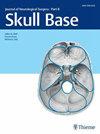Endoscopic endonasal approach for clival chordomas in elderly patients: clinical characteristics, patients outcome and recurrence rate.
IF 0.9
4区 医学
Q3 Medicine
引用次数: 0
Abstract
Abstract Introduction The endoscopic endonasal route has demonstrated to be the approach of choice for a large majority of clival chordomas (CCs). However, its results in elderly patients are under-evaluated in the literature. The aim of this study is to assess the surgical outcome for these patients, determining the factors associated with a larger tumor resection in this population. Materials and Methods Our institutional database of CC has been retrospectively reviewed, to identify all cases over 65 years old, operated through an endoscopic endonasal approach (EEA). Preoperative clinical and radiological features were considered, as well as surgical results, morbidity, and patients' outcome at follow-up. Results Out of our series of 143 endoscopic surgical procedures for CC, 34 (23.8%) were in patients older than 65 and 10 in older than 75 (7.0%). Gross tumor removal was achieved in 22 cases (64.7%). Complications consisted of 2 (5.9%) postoperative cerebrospinal leaks, 1 (2.9%) meningitis, 1 (2.9%) permanent cranial nerve VI palsy, 1 (2.9%) pneumonia, and 2 (5.9%) urinary infections. In 39.1% of cases, the preoperative ophthalmoplegia improved or resolved. Twenty-seven patients (79.4%) underwent radiation therapy. At follow-up (37.7 ± 44.9 months), 13 patients (38.2%) showed a recurrence/progression and 13 (38.3%) deceased. Conclusion EEA can be a useful approach in elderlies, balancing the large tumor removal with an acceptable morbidity rate, even if higher than that for general CC population. However, patient selection remains crucial. A multidisciplinary evaluation is important to assess not only their medical conditions, but also their social and familiar conditions.经鼻内窥镜入路治疗老年斜坡脊索瘤:临床特点、预后及复发率。
内镜下鼻内路径已被证明是绝大多数斜坡脊索瘤(CCs)的选择方法。然而,其在老年患者中的结果在文献中被低估。本研究的目的是评估这些患者的手术结果,确定与该人群中更大肿瘤切除术相关的因素。材料和方法回顾性分析了我们机构的CC数据库,以确定所有65岁以上,经内镜鼻内入路(EEA)手术的病例。术前临床和放射学特征,以及手术结果,发病率和患者随访结果被考虑在内。在我们的143例CC内镜手术中,34例(23.8%)发生在65岁以上的患者中,10例(7.0%)发生在75岁以上的患者中。22例(64.7%)肿瘤全部切除。并发症包括术后脑脊液漏2例(5.9%),脑膜炎1例(2.9%),永久性脑神经VI麻痹1例(2.9%),肺炎1例(2.9%),泌尿系统感染2例(5.9%)。39.1%的病例术前眼麻痹改善或消失。27例(79.4%)患者行放射治疗。随访(37.7±44.9个月),复发/进展13例(38.2%),死亡13例(38.3%)。结论EEA是一种有效的方法,可以平衡大肿瘤切除和可接受的发病率,即使高于一般CC人群。然而,患者选择仍然至关重要。多学科评估不仅对评估他们的医疗状况,而且对评估他们的社会和熟悉状况也很重要。
本文章由计算机程序翻译,如有差异,请以英文原文为准。
求助全文
约1分钟内获得全文
求助全文
来源期刊

Journal of Neurological Surgery Part B: Skull Base
CLINICAL NEUROLOGY-SURGERY
CiteScore
2.20
自引率
0.00%
发文量
516
期刊介绍:
The Journal of Neurological Surgery Part B: Skull Base (JNLS B) is a major publication from the world''s leading publisher in neurosurgery. JNLS B currently serves as the official organ of several national and international neurosurgery and skull base societies.
JNLS B is a peer-reviewed journal publishing original research, review articles, and technical notes covering all aspects of neurological surgery. The focus of JNLS B includes microsurgery as well as the latest minimally invasive techniques, such as stereotactic-guided surgery, endoscopy, and endovascular procedures. JNLS B is devoted to the techniques and procedures of skull base surgery.
 求助内容:
求助内容: 应助结果提醒方式:
应助结果提醒方式:


